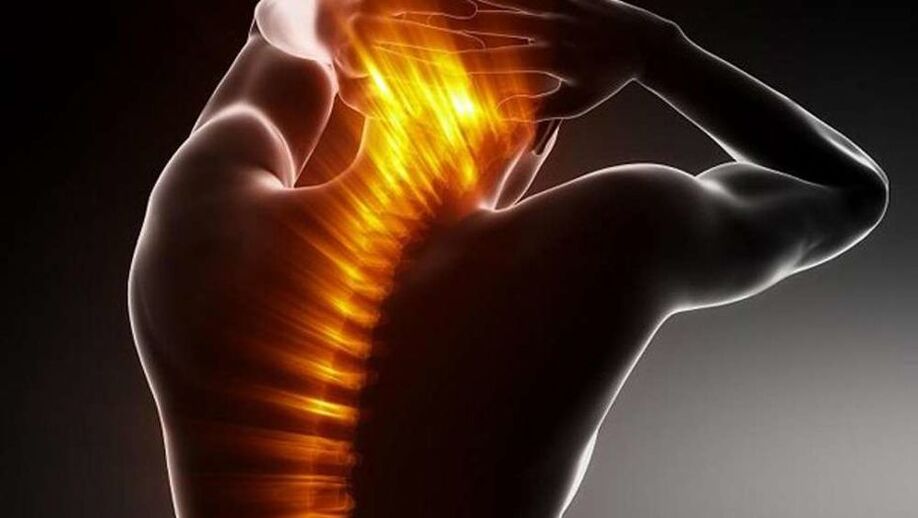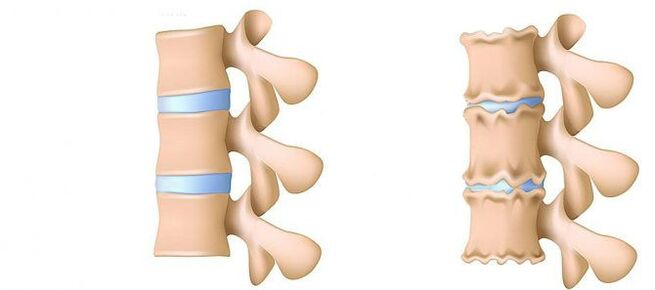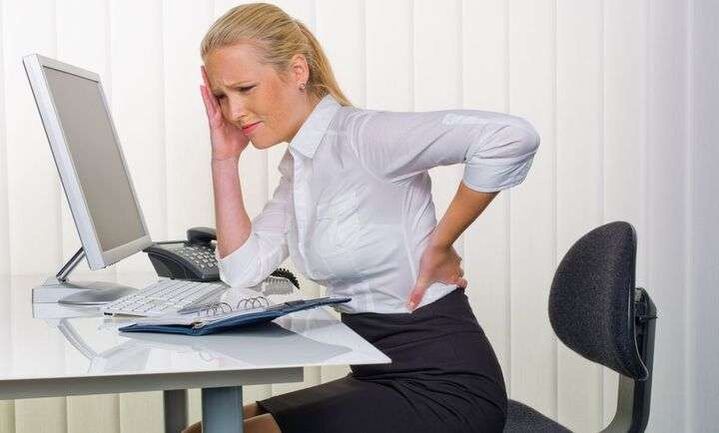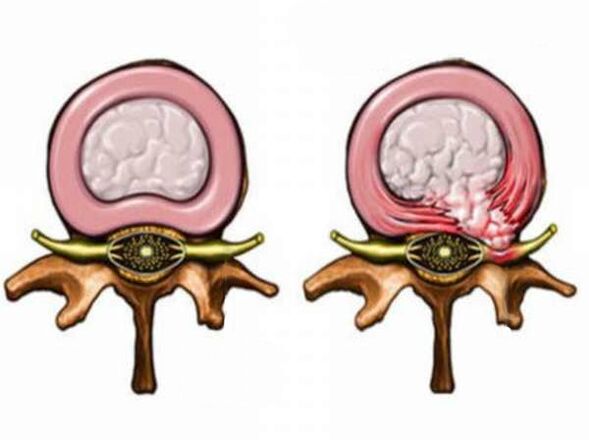Protest, hernia, osteochondrosis - when diagnosed, patients immediately rush to the surgeon regardless of conservative treatment methods, but this is wrong.

According to statistics, 84% of people at least once in their lives hurt.The spine and surrounding muscles are part of the muscular system.Consequently, their damage is often associated with pain, which can occur after the slope or curves of the head and body and weaken at rest.Anatomically, the spine is represented by alternative beads and intervertebral discs.The latter over time is subject to the degeneration process, which leads to the formation of extensions and hernias.These structures themselves can cause pain and can cause pain by compressing neighboring structures - nerve roots and spinal ligaments.In some cases, they can cause stenosis (narrowing) of the spinal canal (the space in which the spinal cord is located).
Among other things, the beads are connected to facial joints in pairs, the structure is more rigid than the intervertebral disc.Their damage in 15-65% of cases causes back pain.Up to 30% of the lower back pain is due to the lesion of the paired sacral and illegal structure that connects the sacrum and pelvic bones.After all, any irritation increases the tone of the surrounding muscles, which over time causes a special myophassial syndrome.
As a rule, physical activity leads to back pain, especially in cases where it is expressed either intense, or when it is produced in an unnatural position, or when associated with a long stay in a forced position, for example, behind the wheel of a car or in a desktop.Body weight and a person's physical training are of great importance, as the severity of the load is always relative.
What are the reasons for its development?
It is impossible to call unequivocally the causes of the development of osteochondrosis, but a number of factors that contribute to the occurrence of this disease can be shown: poor physical development, a violation of metabolism in the body, genetic predisposition, improper stay, prolonged stay in a position (for example, prior to computer monitoring), hypodinamia.As a rule, these reasons are combined with irrational nutrition.
What should you do if there is back pain?
The most important rule is not itself -it is well -known!
Initially, it is necessary to meet with a neurologist or neurosurgeon.To establish an accurate diagnosis, a comprehensive examination of the patient is needed, including necessarily spinal radiography and tomography (magnetic resonance or X -ray calculated. The purpose of this or that study should be performed only by a physician who participates on a specific clinical picture.
Drug care for spinal osteochondrosis involves not only the removal of pain syndrome but also, if possible, eliminate the causes of the root.The doctor prescribes complex therapy (medication therapy, physiotherapy, acupuncture, balneotherapy)
Complex therapeutic care for osteochondrosis includes the strength and correction of the lifestyle (healthy and active lifestyle, optimal volume of physical education), the purpose, in some cases - chondroprotectors drugs that improve the condition of cartilage tissue.
The main indication of surgical treatment for degenerative-district disease is inefficiency of conservative medication therapy for 4-6 weeks, without awareness of pain, as well as increased weakness in the foot, which in a number of cases can be associated with urinary incontinence.Premature and improper treatment in such situations can lead to a number of consequences and adverse complications, up to disability.
Back pain is known as the most common.Experts explain this about the features of human anatomy.The thing is that the spine is subject to the loads of a person's life: from the moment he rises to his feet in childhood until his death.The spinal column gets tired, and sooner or later problems with it arise in almost everyone.The most common diagnostics made with back pain: "osteochondrosis" and "radiculitis", while often patients place them themselves and prescribe treatment themselves without seeking advice for doctors.However, even for these diagnoses, which, it will seem, everyone is listening, often there are reason that only one experienced specialist can determine.
What hurts there?
In the vast majority (about 95%), the pain is associated with muscles, ligaments and joints.People are called to pull their backs.These pains are uncomfortable but not sensitive and in most cases spend themselves in 2-3 days.
3-4% of the pains are associated with radiculopathy (radiculitis) - spinal root damage.Is usually damaged by a hernia.Pain disappears when edema that was raised due to compression passes.
1-2% of back pain is caused by spinal cord injuries or inflammatory diseases, oncological processes, cardiovascular disease or gastrointestinal tract, in which pain syndrome can go to the spine.This is the most dangerous type of back pain.To rule out such pathologies, make sure you consult a doctor.
You can't delay
The main indicator you need for medical care is the regularity of pain.If you are twisted from time to time, most likely there is nothing wrong with.If the pain of low or medium intensity you woke up you ruthless, you cannot hesitate.It is urgent to consult a doctor if the pain is associated with a temperature rise or the pain increases against a background treatment.
Types of pain
Doctors distinguish 3 types of pain, which most often make themselves feel on their backs.The doctor's task is to accurately determine what kind of pain is concerned for the patient for the patient who contacted him, because each of them will be treated exclusively in his own way.
Nociceptive painOr, more simply, pain in receptors - in the skin, muscles, ligaments, joints - is considered more common.The reasons that cause it in X -ray or using calculated tomography are usually not visible.In this case, the specialist makes a diagnosis based on the symptoms the patient speaks of.The causes of muscle spasm can be, for example, physical activity, when a person raised something heavy, significantly supported or a temperature change (an ordinary air conditioning air).This type of pain is treated with two types of medicines.
Acute pain is treated with sedatives of anti -inflammatory drugs and relaxing muscle drugs.In this case, there can be no other therapy.When pain syndrome is removed, we recommend that the patient strengthen the muscles with physical education.This is the treatment and prevention of the disease for the future.
Physical exercises not only help to strengthen muscle, but also contribute to the production of endorphins, as well as serotonin and norepinephrine in the body.These substances increase a person's pain threshold and remove the depressive state.
Neuropathic painOr nerve pain, people are more commonly known as radiculitis.This kind of pain in humans occurs, in particular, when vertebral hernia becomes great and tightens nerve endings.At the same time, experts warn patients and the entire professional community against improper diagnosis in cases where X -rays and use of MRI results that hernia or any other type of spinal coating is available, but it is not so significant to affect the nerve.It is necessary to carefully understand the true cause of the pain.It is possible to blame a muscle spasm, and this type of pain is completely different, and the treatment will also change for it.What is considered to be osteochondrosis is not only manifested by pain but also the norm.

Osteochondrosis is a sign of body aging.But "osteochondrosis" and "pain" are not the same.Since there are virtually no nerve endings in the bone tissue, the extension (the initial phase of the intervertebral disc herniation. - Auth.) Or a hernia cannot damage.Even the studies were done: MRI became groups of people - they chose, mostly those who had never addressed a doctor with complaints of back pain, but they found hernia and osteochondrosis.
Moreover, the doctor gives examples when patients received treatment - and they developed, despite the fact that osteochondrosis remained in the picture.Osteochondrosis today is a concept used locally.
There are places where the word "osteochondrosis" is not used at all.Last year, they officially said this diagnosis was made by past generation neurologists.Outside the country, when the patient is waiting and says his back hurts, he is diagnosed with nonspecific pain in the back, but it is understood that a person has given a load on the muscles.
Confirmation that the pain is precisely caused by radiculitis, and not spasm, for specialists, symptoms in the form of pain in the back of the back, which give the nerve in the leg, is most often for specialists.
The cause of nerve pain can also be complications caused by diabetes and herpes.In diabetes mellitus, patients often complain of pain, as the disease damages the nervous system.Postherpetic neuralgia is characterized by redness strips along the damaged nerve and, accordingly, pain.There are special medicines for the treatment of nerve pain.
For the treatment of neuropathic pain, anti -epileptic and antidepressants are used.The name of the medication of this patient orientation, I must say, often scare, so it is important for them to explain that it is antidepressants that increase the threshold of pain.These are standards of pain treatment.
Psychogenicor chronic.This kind of pain is not caused by physical changes in the human body, its mental state changes.Symptoms torment the patient in this case for a long time.At the same time, it hurts, as a rule, not just the back.
It happens that people come and say everything-to-ground, back constantly.You ask: Something heavy raised?No!And there is no clear localization.In this case, we can conclude that the patient has reduced the pain threshold and a pain analyzer, which is in the brain, constantly makes himself feel.It can cause pain in such a patient: excessive work, stress, a feeling of fear.

The anesthetic medication in this case will not help.Specialists usually prescribe antidepressants, physical education for patients with chronic pain, but sometimes it is enough to find a reason using a psychologist or psychiatrist.
A young woman who complained about her back pain: six months, he says, tried.I recommended that she go to a psychologist and physical education.A few days later she again came completely healthy without taking medication.The psychologist helped her realize that the cause of stress pain: she had family problems, physical education helped to relax.
HomeThe most effective medicine is anti -inflammatory oral medication.Just don't overdo it - they are only safe for the first time.With prolonged use, such medicines can cause ulcers and bleeding in the gastric mucosa.Traditional home treatment - non -Sotal ointments - can only be used as an additional measure.They are harmless but ineffective.Carsset also gives relief - the fixing discharges the spine, relieves spasms and limits sharp movements.Only corset should be common - elastic, not warming.
If the treatment has no effect for three days, you should consult a doctor who will make the blockade with anti -inflammatory injections.Due to the removal of spasms and muscle relaxation, the pain leaves immediately and often permanently.
Forbidden!
Bath and massage under strict prohibition.They improve edema and pain.
Contact manual therapists in the newspaper.Manual therapy is the area where each specialist constitutes three hundred charlatans.If you really want to find a good doctor, you should contact the certified clinics where graduate specialists work.
It is important to immediately determine the treatment tactics correctly.This should be done by a neurologist or neurosurgeon.It is dangerous to treat your back.30% of neurosurgical department patients proved home treatment methods and this brought themselves to a hospital bed.
When the pills do not help
If the drug treatment prescribes a therapist or a neuropathologist does not give results within 3-6 months and the pain continues to torment the patient, the doctor is forced to pass the patient to another specialist.In some situations, physiotherapy can provide considerable assistance.It is suitable for the first two types of pain: in receptors and nerves.Physiotherapy has been prescribed to those patients who have an allergy to medicines or stomach problems.
Because of this, the treatment passes, but it has no effect, patients often come to us severe, with depression, so we approach their multidisciplinary treatment with the involvement of various specialists: neuropathologists, psychologists, physiotherapists, neurosurgeons.
Among the methods used by local physiotherapists, borrowed from Russian colleaguesIntracanic electric stimulation.Its principle is that through a special needle electrode available, bypassing the skin barrier, to supply electricity, directly to the focus of the pain.Diagnoses in which this procedure is prescribed, including extension and hernia.The procedure, according to experts, is comfortable and does not require pain relief.The effect, as a rule, is felt after the first procedure.In total, they are set from 3 to 6.
In addition, it is usedLaser therapy.This technique is also suitable for the fact that it can be prescribed to patients with different stimulants, including cardio- and does not worry that failure will occur.Laser is used not only for the treatment of diseases associated with spine problems, but also as the treatment of diabetes and herpes sugar complications, which were already discussed.
Laser promotes good recovery.Moreover, the device improves microcirculation in the spine itself, and because of this, the power of the disks improves.As a result, edema and inflammation are removed, and the pain, respectively, is removed.
lock
Such a thing as the "blockade" in medicine is not new.With severe pain, as Soviet times, patients were prescribed injections in the area where the concentration of pain is directly.Since then, little has changed in the prefecture clinics.Meanwhile, in accordance with international recommendations, these procedures must be performed exclusively under control, using special equipment that allows you to monitor the process in real time.The consequences of an unsuccessful injection can be very different: at best, the medicine, presented not where necessary, will not give the necessary effect, at worst - this is fraught with serious complications.
The introduction of the drug should be performed under radiological control: fluoroscopy, CT, MRI, ultrasound, because the medicine is administered in order where the source is of pain.If the doctor gets wrong, this is fraught with the prohibition of patient breathing and total spinal anesthesia.
The essence of the blockade is that the drug presented for several months to six months prevents the spread of the impulse through the nerve, which is involved in the nerve pulse.Although this procedure does not guarantee a continuous effect, it significantly improves the quality of life of the patient: a person temporarily forgets about pain, can sleep calmly or go to his business.
Surgery - the elimination of pain
When medicines do not help - neither pills nor injections, when physiocracy is ineffective, neurosurgeons come to the rescue.Modern technologies allow these experts to return to the painless life of patients suffering from him for not a year.There are many methods: from manipulations with the minimum interference in the body to complex surgical operations with vertebral prosthetics.

With hernia that drank nerve, one of the most common and effective methods is knownRadio frequency ablation.In fact, this is a type of blockade, only instead of a medicine that relieves pain for only a while, an electric current is used that can completely solve the problem.Often, ablation is after blockade, thanks to which doctors take on a clear understanding of which nerve is needed to affect.The procedure is provided both on a paid and quota.
The procedure is performed within 20 minutes.It is called an operation, but in fact it is a surgical manipulation that is done under local anesthesia, necessarily under the control of special equipment.First, the pain syndrome is reproduced and, if the patient confirms that this is exactly the pain he usually experiences, we give a pulse discharge - and the pain, so to say, is disconnected.
In special cases, methods are usedneurostimulationAmong them is the application of the electrode.The patient is performed: the surgeon puts a small device in the focus of pain, which will suppress real -time pain impulses.Patients take this procedure with quota.
There are times when they have already made different types of surgical interventions, but the pain syndrome is stored on one scale or another, then we put a stimulant - first in the test mode, and if the desired effect is achieved, then we set it up for good.This is an operation that is performed with a small cut.The only thing is that the patient will have to come periodically for test control.
What we risk
The risk of surgery, due to which it is postponed or rejected at all, many patients consider it very exaggerated.In neurosurgery, there are technologies that allow you to accurately calculate the effectiveness of the surgery and which symptoms will disappear behind it and which will remain.
The probability of pain renewal after surgery does not exceed 1-1.5%.Plants in other countries can really appear, but this is not a complication, but the spread of the disease, which is often found in young unruly patients.Once they turn away from the pain, they return to the usual lifestyle: they drive behind the wheel, resume training.And this is categorically impossible to do.
Is the fault of osteochondrosis for everything?
Osteochondrosis is a chronic degenerative-district change in the intervertebral space.All people over 25 have signs of osteochondrosis.It is impossible to avoid osteochondrosis, but you can protect yourself from its complications, which cause back pain.
Why so, and not different?
Should I spend time, effort and money for treatment: tablets, injections, physiotherapy, if you can do a minor surgery immediately and get rid of pain once and for all?- Patients have asked this question more and more often.The answer is usually unclear: Yes, you need!The thing is that with accurate diagnosis and proper treatment, units achieve surgeries.The rest get rid of pain in the early stages of aid - on average, 30% of patients at each stage are in production.
A mistake when people, after seeing an extension or hernia in the picture, immediately run to the surgeon, bypassing the previous aid specialists.In cases where the changes are insignificant, surgery is not required.Moreover, with the style of proper life - engaged in physiotherapy exercises, swimming, monitoring his body weight - a person with the so -called osteochondrosis can feel healthy and not experience pain.
It is important that at each stage the patient has an accurate diagnosis and to describe the correct treatment.This can only be achieved collegial.Proposed also proposed, for the example of foreign experience, present a new specialization, such as an algologist, is a type of pain specialized therapist, a physician who has knowledge of a neurologist and intruder anesthetist, capable of treating, without surgery, but if surgical intervention will not doubt the patient.



































